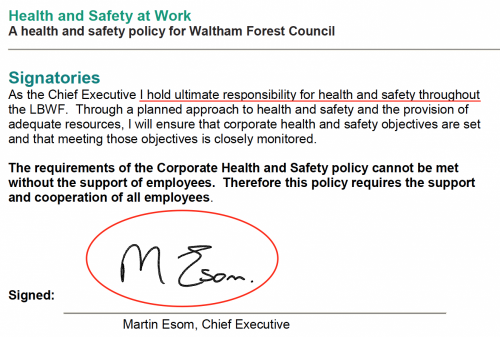LBWF CEO Martin Esom’s appointment to the Health and Safety Executive Board: a step far too far
In July of this year, LBWF CEO Martin Esom joined the Health and Safety Executive (HSE) as a part-time non-executive director – a post that entails approximately 30 days commitment per year for a remuneration of no less than £15,100 (that is £503 per day).
The HSE obviously values Mr. Esom highly, with its press release citing, amongst other things, his background in environmental health, his succession of senior local authority positions, his MBA, and his chairing of the London Prevent Board.
Yet locally, news of Mr. Esom’s appointment has been greeted with puzzlement, even derision.
What fuels these reactions is the fact that in recent years LBWF has a distinctly poor health and safety record, and indeed on two occasions, ironically enough, has fallen foul of major HSE prosecutions, the first in 2015, the second – with exquisite timing – in July 2017.
Previous posts, referenced below, rehearse the details, but briefly the cases relate to respectively LBWF’s mismanagement of asbestos in the Town Hall basement up to 2012; and similar recklessness by its part-owned joint venture, NPS London Ltd. (as Mr. Esom called them, ‘our asbestos advisers’), at St. Mary’s Primary School in Walthamstow during 2011-12.
Both cases exposed major flaws in past procedure, and involved workers’ lives being put in mortal danger. The HSE lead investigator’s statement after the trial in 2015 said much about the sheer scale of the failure:
‘Waltham Forest was aware of the asbestos in the basement as far back as 1984. It was also aware of the risks from asbestos exposure and of its duty to manage those risks. However, the authority singularly failed to do so over more than a decade. Over that period, an unquantifiable number of its own employees plus workers from maintenance companies and similar were regularly exposed to these hazards’.
Of course, as far as is known Mr. Esom was not personally involved in the specific events that led up to either of these calamities, and neither is there any suggestion that he committed any impropriety.
However, that said, Mr. Esom cannot be absolved of all responsibility, simply because as regards asbestos, he was the man with the power.
At LBWF, his position was almost absolute. For example, when a new a new and all-embracing Health And Safety directive was adopted in January 2011, it was Mr. Esom who was at its very centre, as a resounding flourish at the end of the document (red ink added) amply illustrates:
Meanwhile, at NPS London Ltd. – perhaps surprisingly – Mr. Esom also possessed significant influence.
This came about because LBWF’s part-ownership entitled it to two places on the NPS London Ltd. board and while one of these was habitually reserved for a senior councillor from the ruling administration (with Afzal Akram, Clare Coghill, Mark Rusling, Chris Robbins, and Terence Wheeler taking turns to do the honours), in 2007-08, and then 2010-14, Mr. Esom took up the other.
So all in all, it is inevitable that whenever LBWF’s dismal health and safety record during recent years is considered, Mr. Esom’s name will figure.
And that, in a nutshell, is why for those who follow events in Waltham Forest his elevation to the senior ranks of the HSE is a step far too far.

